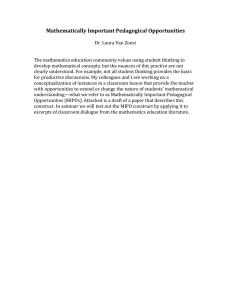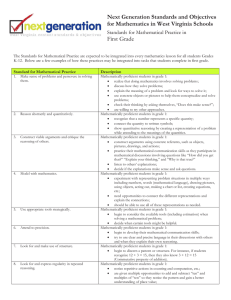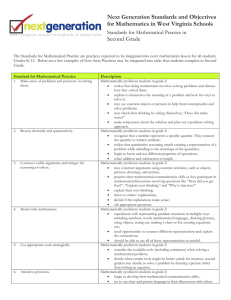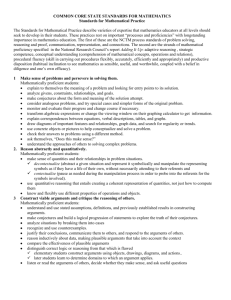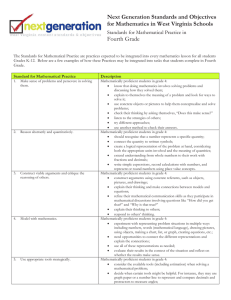Math, Science, and Engineering Practices
advertisement
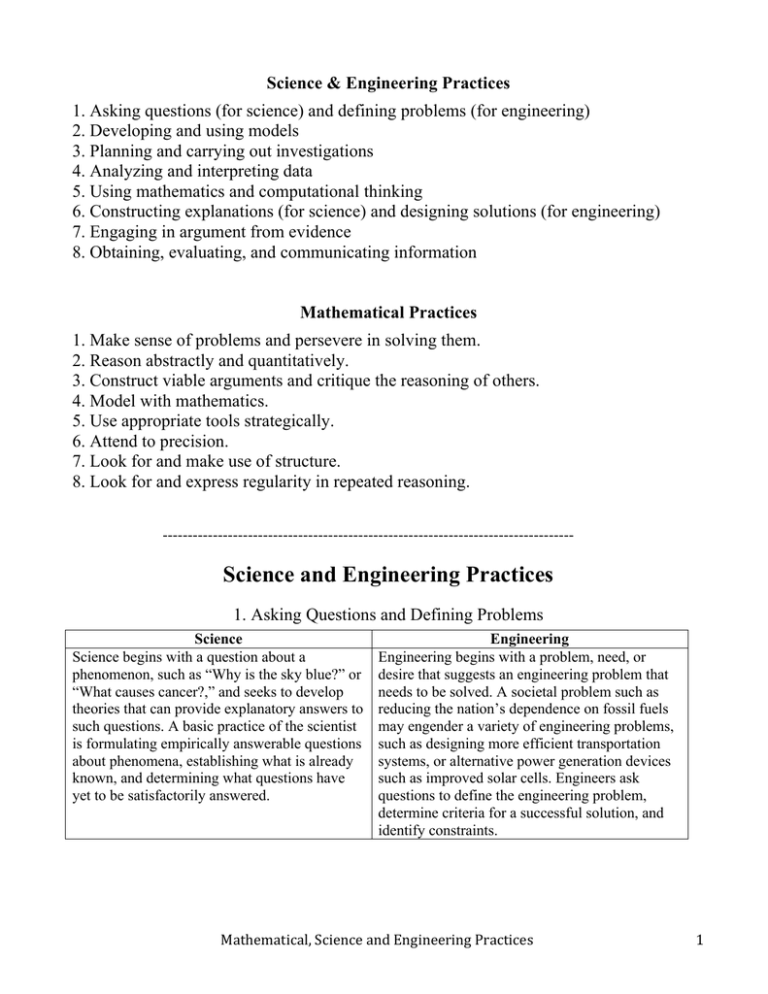
Science & Engineering Practices 1. Asking questions (for science) and defining problems (for engineering) 2. Developing and using models 3. Planning and carrying out investigations 4. Analyzing and interpreting data 5. Using mathematics and computational thinking 6. Constructing explanations (for science) and designing solutions (for engineering) 7. Engaging in argument from evidence 8. Obtaining, evaluating, and communicating information Mathematical Practices 1. Make sense of problems and persevere in solving them. 2. Reason abstractly and quantitatively. 3. Construct viable arguments and critique the reasoning of others. 4. Model with mathematics. 5. Use appropriate tools strategically. 6. Attend to precision. 7. Look for and make use of structure. 8. Look for and express regularity in repeated reasoning. ---------------------------------------------------------------------------------- Science and Engineering Practices 1. Asking Questions and Defining Problems Science Science begins with a question about a phenomenon, such as “Why is the sky blue?” or “What causes cancer?,” and seeks to develop theories that can provide explanatory answers to such questions. A basic practice of the scientist is formulating empirically answerable questions about phenomena, establishing what is already known, and determining what questions have yet to be satisfactorily answered. Engineering Engineering begins with a problem, need, or desire that suggests an engineering problem that needs to be solved. A societal problem such as reducing the nation’s dependence on fossil fuels may engender a variety of engineering problems, such as designing more efficient transportation systems, or alternative power generation devices such as improved solar cells. Engineers ask questions to define the engineering problem, determine criteria for a successful solution, and identify constraints. Mathematical, Science and Engineering Practices 1 2. Developing and Using Models Science Science often involves the construction and use of a wide variety of models and simulations to help develop explanations about natural phenomena. Models make it possible to go beyond observables and imagine a world not yet seen. Models enable predictions of the form “if . . . then . . . therefore” to be made in order to test hypothetical explanations. Engineering Engineering makes use of models and simulations to analyze existing systems so as to see where flaws might occur or to test possible solutions to a new problem. Engineers also call on models of various sorts to test proposed systems and to recognize the strengths and limitations of their designs. 3. Planning and Carrying Out Investigations Science Scientific investigation may be conducted in the field or the laboratory. A major practice of scientists is planning and carrying out a systematic investigation, which requires the identification of what is to be recorded and, if applicable, what are to be treated as the dependent and independent variables (control of variables). Observations and data collected from such work are used to test existing theories and explanations or to revise and develop new ones. Engineering Engineers use investigation both to gain data essential for specifying design criteria or parameters and to test their designs. Like scientists, engineers must identify relevant variables, decide how they will be measured, and collect data for analysis. Their investigations help them to identify how effective, efficient, and durable their designs may be under a range of conditions. 4. Analyzing and Interpreting Data Science Scientific investigations produce data that must be analyzed in order to derive meaning. Because data usually do not speak for themselves, scientists use a range of tools—including tabulation, graphical interpretation, visualization, and statistical analysis—to identify the significant features and patterns in the data. Sources of error are identified and the degree of certainty calculated. Modern technology makes the collection of large data sets much easier, thus providing many secondary sources for analysis. Engineering Engineers analyze data collected in the tests of their designs and investigations; this allows them to compare different solutions and determine how well each one meets specific design criteria—that is, which design best solves the problem within the given constraints. Like scientists, engineers require a range of tools to identify the major patterns and interpret the results. Mathematical, Science and Engineering Practices 2 5. Using Mathematics and Computational Thinking Science In science, mathematics and computation are fundamental tools for representing physical variables and their relationships. They are used for a range of tasks, such as constructing simulations, statistically analyzing data, and recognizing, expressing, and applying quantitative relationships. Mathematical and computational approaches enable predictions of the behavior of physical systems, along with the testing of such predictions. Moreover, statistical techniques are invaluable for assessing the significance of patterns or correlations. Engineering In engineering, mathematical and computational representations of established relationships and principles are an integral part of design. For example, structural engineers create mathematically based analyses of designs to calculate whether they can stand up to the expected stresses of use and if they can be completed within acceptable budgets. Moreover, simulations of designs provide an effective test bed for the development of designs and their improvement. 6. Constructing Explanations and Designing Solutions Science Engineering The goal of science is the construction of theories that can provide explanatory accounts of features of the world. A theory becomes accepted when it has been shown to be superior to other explanations in the breadth of phenomena it accounts for and in its explanatory coherence and parsimony. Scientific explanations are explicit applications of theory to a specific situation or phenomenon, perhaps with the intermediary of a theory-based model for the system under study. The goal for students is to construct logically coherent explanations of phenomena that incorporate their current understanding of science, or a model that represents it, and are consistent with the available evidence. Engineering design, a systematic process for solving engineering problems, is based on scientific knowledge and models of the material world. Each proposed solution results from a process of balancing competing criteria of desired functions, technological feasibility, cost, safety, esthetics, and compliance with legal requirements. There is usually no single best solution but rather a range of solutions. Which one is the optimal choice depends on the criteria used for making evaluations. 7. Engaging in Argument from Evidence Science Engineering In science, reasoning and argument are essential for identifying the strengths and weaknesses of a line of reasoning and for finding the best explanation for a natural phenomenon. Scientists must defend their explanations, formulate evidence based on a solid foundation of data, examine their own understanding in light of the evidence and comments offered by others, and collaborate with peers in searching for the best explanation for the phenomenon being investigated. In engineering, reasoning and argument are essential for finding the best possible solution to a problem. Engineers collaborate with their peers throughout the design process, with a critical stage being the selection of the most promising solution among a field of competing ideas. Engineers use systematic methods to compare alternatives, formulate evidence based on test data, make arguments from evidence to defend their conclusions, evaluate critically the ideas of others, and revise their designs in order to achieve the best solution to the problem at hand. Mathematical, Science and Engineering Practices 3 8. Obtaining, Evaluating, and Communicating Information Science Engineering Science cannot advance if scientists are unable to communicate their findings clearly and persuasively or to learn about the findings of others. A major practice of science is thus the communication of ideas and the results of inquiry—orally, in writing, with the use of tables, diagrams, graphs, and equations, and by engaging in extended discussions with scientific peers. Science requires the ability to derive meaning from scientific texts (such as papers, the Internet, symposia, and lectures), to evaluate the scientific validity of the information thus acquired, and to integrate that information. Engineers cannot produce new or improved technologies if the advantages of their designs are not communicated clearly and persuasively. Engineers need to be able to express their ideas, orally and in writing, with the use of tables, graphs, drawings, or models and by engaging in extended discussions with peers. Moreover, as with scientists, they need to be able to derive meaning from colleagues’ texts, evaluate the information, and apply it usefully. In engineering and science alike, new technologies are now routinely available that extend the possibilities for collaboration and communication. Mathematical Practices The Standards for Mathematical Practice describe varieties of expertise that mathematics educators at all levels should seek to develop in their students. These practices rest on important “processes and proficiencies” with longstanding importance in mathematics education. The first of these are the NCTM process standards of problem solving, reasoning and proof, communication, representation, and connections. The second are the strands of mathematical proficiency specified in the National Research Council’s report Adding It Up: adaptive reasoning, strategic competence, conceptual understanding (comprehension of mathematical concepts, operations and relations), procedural fluency (skill in carrying out procedures flexibly, accurately, efficiently and appropriately), and productive disposition (habitual inclination to see mathematics as sensible, useful, and worthwhile, coupled with a belief in diligence and one’s own efficacy). 1. Make sense of problems and persevere in solving them. Mathematically proficient students start by explaining to themselves the meaning of a problem and looking for entry points to its solution. They analyze givens, constraints, relationships, and goals. They make conjectures about the form and meaning of the solution and plan a solution pathway rather than simply jumping into a solution attempt. They consider analogous problems, and try special cases and simpler forms of the original problem in order to gain insight into its solution. They monitor and evaluate their progress and change course if necessary. Older students might, depending on the context of the problem, transform algebraic expressions or change the viewing window on their graphing calculator to get the information they need. Mathematically proficient students can explain correspondences between equations, verbal descriptions, tables, and graphs or draw diagrams of important features and relationships, graph data, and search for regularity or trends. Younger students might rely on using concrete objects or pictures to help conceptualize and solve a problem. Mathematically proficient students check their answers to problems using a different method, and they continually ask themselves, “Does this make sense?” They can understand the approaches of others to solving complex problems and identify correspondences between different approaches. Mathematical, Science and Engineering Practices 4 2. Reason abstractly and quantitatively. Mathematically proficient students make sense of quantities and their relationships in problem situations. They bring two complementary abilities to bear on problems involving quantitative relationships: the ability to decontextualize—to abstract a given situation and represent it symbolically and manipulate the representing symbols as if they have a life of their own, without necessarily attending to their referents—and the ability to contextualize, to pause as needed during the manipulation process in order to probe into the referents for the symbols involved. Quantitative reasoning entails habits of creating a coherent representation of the problem at hand; considering the units involved; attending to the meaning of quantities, not just how to compute them; and knowing and flexibly using different properties of operations and objects. 3. Construct viable arguments and critique the reasoning of others. Mathematically proficient students understand and use stated assumptions, definitions, and previously established results in constructing arguments. They make conjectures and build a logical progression of statements to explore the truth of their conjectures. They are able to analyze situations by breaking them into cases, and can recognize and use counterexamples. They justify their conclusions, communicate them to others, and respond to the arguments of others. They reason inductively about data, making plausible arguments that take into account the context from which the data arose. Mathematically proficient students are also able to compare the effectiveness of two plausible arguments, distinguish correct logic or reasoning from that which is flawed, and—if there is a flaw in an argument—explain what it is. Elementary students can construct arguments using concrete referents such as objects, drawings, diagrams, and actions. Such arguments can make sense and be correct, even though they are not generalized or made formal until later grades. Later, students learn to determine domains to which an argument applies. Students at all grades can listen or read the arguments of others, decide whether they make sense, and ask useful questions to clarify or improve the arguments. 4. Model with mathematics. Mathematically proficient students can apply the mathematics they know to solve problems arising in everyday life, society, and the workplace. In early grades, this might be as simple as writing an addition equation to describe a situation. In middle grades, a student might apply proportional reasoning to plan a school event or analyze a problem in the community. By high school, a student might use geometry to solve a design problem or use a function to describe how one quantity of interest depends on another. Mathematically proficient students who can apply what they know are comfortable making assumptions and approximations to simplify a complicated situation, realizing that these may need revision later. They are able to identify important quantities in a practical situation and map their relationships using such tools as diagrams, two-­‐way tables, graphs, flowcharts and formulas. They can analyze those relationships mathematically to draw conclusions. They routinely interpret their mathematical results in the context of the situation and reflect on whether the results make sense, possibly improving the model if it has not served its purpose. 5. Use appropriate tools strategically. Mathematically proficient students consider the available tools when solving a mathematical problem. These tools might include pencil and paper, concrete models, a ruler, a protractor, a calculator, a spreadsheet, a computer algebra system, a statistical package, or dynamic geometry Mathematical, Science and Engineering Practices 5 software. Proficient students are sufficiently familiar with tools appropriate for their grade or course to make sound decisions about when each of these tools might be helpful, recognizing both the insight to be gained and their limitations. For example, mathematically proficient high school students analyze graphs of functions and solutions generated using a graphing calculator. They detect possible errors by strategically using estimation and other mathematical knowledge. When making mathematical models, they know that technology can enable them to visualize the results of varying assumptions, explore consequences, and compare predictions with data. Mathematically proficient students at various grade levels are able to identify relevant external mathematical resources, such as digital content located on a website, and use them to pose or solve problems. They are able to use technological tools to explore and deepen their understanding of concepts. 6. Attend to precision. Mathematically proficient students try to communicate precisely to others. They try to use clear definitions in discussion with others and in their own reasoning. They state the meaning of the symbols they choose, including using the equal sign consistently and appropriately. They are careful about specifying units of measure, and labeling axes to clarify the correspondence with quantities in a problem. They calculate accurately and efficiently, express numerical answers with a degree of precision appropriate for the problem context. In the elementary grades, students give carefully formulated explanations to each other. By the time they reach high school they have learned to examine claims and make explicit use of definitions. 7. Look for and make use of structure. Mathematically proficient students look closely to discern a pattern or structure. Young students, for example, might notice that three and seven more is the same amount as seven and three more, or they may sort a collection of shapes according to how many sides the shapes have. Later, students will see 7 × 8 equals the well remembered 7 × 5 + 7 × 3, in preparation for learning about the distributive property. In the expression x2 + 9x + 14, older students can see the 14 as 2 × 7 and the 9 as 2 + 7. They recognize the significance of an existing line in a geometric figure and can use the strategy of drawing an auxiliary line for solving problems. They also can step back for an overview and shift perspective. They can see complicated things, such as some algebraic expressions, as single objects or as being composed of several objects. For example, they can see 5 – 3(x – y)2 as 5 minus a positive number times a square and use that to realize that its value cannot be more than 5 for any real numbers x and y. 8. Look for and express regularity in repeated reasoning. Mathematically proficient students notice if calculations are repeated, and look both for general methods and for shortcuts. Upper elementary students might notice when dividing 25 by 11 that they are repeating the same calculations over and over again, and conclude they have a repeating decimal. By paying attention to the calculation of slope as they repeatedly check whether points are on the line through (1, 2) with slope 3, middle school students might abstract the equation (y – 2)/(x – 1) = 3. Noticing the regularity in the way terms cancel when expanding (x – 1)(x + 1), (x – 1)(x2 + x + 1), and (x – 1)(x3 + x2 + x + 1) might lead them to the general formula for the sum of a geometric series. As they work to solve a problem, mathematically proficient students maintain oversight of the process, while attending to the details. They continually evaluate the reasonableness of their intermediate results. Mathematical, Science and Engineering Practices 6
